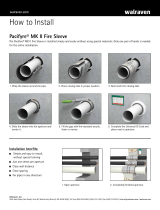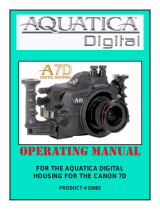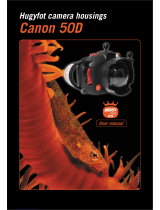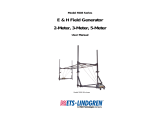Ikelite 6870.40 for Canon EOS 40D User manual
- Category
- Underwater camera housings
- Type
- User manual
This manual is also suitable for

Ikelite SLR-DC Housing
instruction manual
#6870.40 for Canon EOS 40D
Congratulations on your purchase of an Ikelite Digital Camera
Housing. Ikelite has over 40 years of experience in the underwater
photographic and lighting market. Our products are designed and
built in the USA by Ikelite for both the professional and amateur
photographer.
The clear housing permits instant visual inspection of the camera
and all sealing surfaces as well as complete monitoring of controls
and camera LCD screens.
Ikelite Digital Housings are slightly negative in salt water for
stability. This housing has been water pressure tested at the
factory. Housing is pressure tested to 200' (60m).

2

Opening the Housing
Lid Snaps have a Lock.
To open, push Lid Snap Lock
forward and lift as shown.
Keep pressure on the Lid
Snap so it does not fly open
quickly.
Some lid snaps have a lot of
spring tension once they go over center, have a firm grip on the
lid snap. Lid Snaps may be opened one at a time.
3

Installing the Camera
1. Remove the back from
the housing. The
mounting tray for the
camera is secured to the
housing back. Position the
camera and lens on the
tray and secure it with
the mounting bolt which
threads into the camera's
tripod socket.
NOTE: Strobe ID Switch
located on bottom of
camera tray.
Setting the Conversion Circuitry Strobe ID Switch.
On the bottom of the camera tray is a switch for setting the DS
Substrobe ID. Set the switch to the Model of DS Substrobe being
used, SD125orDS51.
• When using dual strobes of
different models such as a DS51 and
a DS125, set the ID switch to DS51.
4

Flash Connection for External Strobes
When using an external strobe connect the housings Hot Shoe
Connector, slide the connector into the hot shoe of the camera
from the back of the camera as shown. Slide the connector
forward until
it stops. This can
be done after
the
camera is
secured with the
mounting
bolt.
Caution:
Do not remove the
External Strobe
Connector's
waterproof cap
unless an
external sync cord
is going to be
plugged in.
Installing Camera in Housing
Before installing the camera, pull out on the controls in the front
section of the housing. This will allow the camera to slide in
easier. Once the camera is installed and the lid snaps have been
closed, return the controls to their operating position.
5

Closing the Housing
1. Place housing face down in your
lap.
2. Check to see that there is an o'ring
on the housing back and that it is
clean and in its proper location.
3. Guide the back onto the housing.
The o'ring should touch the
housing all the way around. There
should be an even gap all the way
around between the housing and
the housing back.
4. Lift the lid snaps so they are
extended and place the lid snap
into the hook on the housing back.
5. To close the housing push
down on the lid snaps until
they snap into place . Lid
snaps on opposite sides of the
housing should be closed at the
same time. Be sure they are down
far enough to engage the lock.
Double check - Once the housing is
closed, check the o'ring seal. Check the gap between the
housing back and the housing, it should be even all the way
around.
Look through the clear plastic back at the o'ring. You should see a
darkened area where the o'ring is compressed against the
housing back. If you do not see an even black compression seal
all the way around the back, open the lid snaps, reseat the
housing back and close the lid snaps. Visually check the seal again.
6

Preparing to Install Zoom Clamp & Gear Sleeve
Determine the type
of lens being used
on the camera.
Type 1 Lenses have
a lens opening that
is NOT larger in
diameter than the
zoom ring. (Fig. 1).
Type 2 Lenses have a lens
opening that IS larger in
diameter than the zoom ring. (Fig. 2).
Zoom Clamps & Gear Sleeves Included with Housing
There are 2 different
Zoom Clamps and
Gear Sleeves
provided with the
housing. Start with
the suggested Zoom
Clamp and Gear
Sleeve depending
on the Type of
lens being used.
See (Fig. A or B)
Normally used with
Type 1 lens (Fig.1)
#9059.8 small diameter clamp:
For use with #0073 sleeve
Normally used with
Type 2 lens (Fig.2)
#5509.28 Package
#9059.9 large diameter clamp:
For use with #0073.1 sleeve
#0073 sleeve: Use with
small diameter zo m clamp o
#9059.8
Figure A
#0073.1 sleeve: Use with
large diameter zoom clamp
#9059.9
Figure B
7

Installing the Zoom Clamp & Gear Sleeve On the Type 1 Lenses
Installing the Zoom Clamp
The Zoom Clamp has springs so it can be expanded to fit over
the Zoom ring of the lens as shown in (Fig. Q. Install the Zoom
Clamp with the extension tabs toward the rear element of the
lens. After installing the Zoom Clamp, check that when rotating
the Zoom Clamp it rotates the Zoom ring on the lens. If the
Zoom Clamp is not tight enough to rotate the Zoom ring on the
lens, remove the Zoom Clamp and install the rubber strips
(supplied) to the inside of the Zoom Clamp as shown (Fig. F).
Two thicknesses of rubber strips are provided. Start by installing
the thinnest rubber strips, if the Zoom Clamp still is not tight
enough use the thicker rubber strips. Reinstall the Zoom Clamp.

Install the Gear Sleeve
After the Zoom Clamp is installed, lower the appropriate Gear
Sleeve over the Zoom Clamp aligning the Gear Sleeve ribs with the
grooves in the Zoom Clamps extended tabs as shown (Fig. D & E),
Note that the ribs of the Gear Sleeve should slide freely in the
grooves of the Zoom Clamp. If the Gear Sleeve does not slide
freely, remove any rubber strips on the inside of the Zoom Clamp,
if no rubber strips are installed then try using the Zoom Clamp
and Gear Sleeve for Type 2 lenses in the #5509.28 package.
Lower the Gear Sleeve into the port opening of the housing so
the teeth on the Gear Sleeve mesh with the teeth on the housing
Drive Gear (Fig. G). When the port is installed it will lock the
Gear Sleeve in place. After installing the port, rotate the housings
Zoom Control Knob to see that the Gear Sleeve is properly
routing the lenses Zoom ring.
9

Installing the Zoom Clamp & Gear Sleeve On Type 2 Lenses
Due to the larger diameter of lens opening on Type 2 lenses, the
Zoom Clamp and Gear Sleeve need to be installed from the rear
(bayonet end) of the lens. Use the housings Lens Release Control
and remove the camera lens from the camera body.
Installing the Zoom Clamp
The Zoom Clamp has springs so
it can be expanded to fit over the
Zoom ring of the lens as shown
in (Fig. I). Install the Zoom Clamp
with the extension tabs toward
the rear element of the lens. After
installing the Zoom Clamp, check
that when rotating the Zoom
Clamp it rotates the
Zoom ring on the
lens. If the Zoom
Clamp is not tight
enough to rotate
the Zoom ring on
the lens, remove
the Zoom Clamp
and install the rubber
strips (supplied) to the inside of
the Zoom Clamp as shown (Fig. H)
Two thickness of rubber strips
are provided. Start by installing
the thinnest rubber strips, if the
Zoom Clamp still is not tight
enough use the thicker rubber
strips. Reinstall the Zoom Clamp,
10

Installing the Gear Sleeve
After the Zoom Clamp is installed.
Place the Gear Sleeve in the port opening of the housing (Fig. I).
Lower the lens through the Gear Sleeve, aligning the grooves in
the Zoom Clamp with the ribs on the Gear Sleeve. Note that the
ribs of the Gear Sleeve should slide freely in the grooves of the
Zoom Clamp. If the Gear Sleeve does not slide freely, remove any
rubber strips on the inside of the Zoom Clamp (Fig. H) or use
thinner rubber strips. Reinstall the Zoom Clamp on the lens and
lower the lens through the Gear Sleeve, aligning the grooves in
the Zoom Clamp with the ribs on the Gear Sleeve. Remount the
lens to the camera body, make sure the lens is locked into the
camera body. Position the Gear Sleeve teeth so they mesh with
the housing drive gear (Fig. J). When the port is installed it will
lock the Gear Sleeve in place After installing the port, rotate the
housings Zoom Control Knob to see that the Gear Sleeve is
properly rotating the lenses Zoom ring.
11

Installing the Port
There are two port locks on
the front of the housing.
(See housing front) Each
port lock has a Release
Button, lift the release
button and slide each Port
Lock away from the port
opening. In the unlocked
position the Release Button
will remain in the up
position as shown.
To prepare the port for installation, remove the port o'ring and
lightly lubricate it. The port seal is a side-to-side seal and
requires the o'ring to be lightly lubricated for easy installation.
Put a small amount of lubricant on your fingers and draw the
o'ring through your fingers to lightly lubricate it. Do not stretch
the o'ring. Check that the lip of the port where the o'ring fits
and the sealing surface on the housing are clean. Place the port,
with o'ring into the housing's port opening. Press down on the
port firmly and evenly until you feel the port slide into place.
Continue to push down on the port and push each port lock
forward until it clicks into place. It may help to slightly rotate
the port as you push in on the port lock. When the port lock
clicks into place the Release Button will drop down against the
port lock.
Check around the perimeter of the port seal to see that the
o'ring is properly sealed and not extruded.
12

Installing the Port cont.
To Remove Port
To remove the port lift up on each Release Button and slide the
port lock away from the port.
Port Seal Inside View
If the port is installed before the
camera is inserted into the housing,
look on the inside of the housings at
the port seal. Check to see that the
o'ring is properly sealed as shown in
figure 1 and not extruded as shown
in figure 2.
Caution:
After installing the port, turn the Zoom Control knob on the
housing. If the Zoom Control is difficult to turn, the gear sleeve
may be warped. If so reduce or omit any rubber installed on the
Zoom Clamp. (Fig. H on pg. 11). If the Zoom Clamp is still warped,
use of the #5509.28 package may be required. (See page 7)
13

Using External Strobes
This housing has Conversion Circuitry built into the camera tray.
When used with Ikelite DS Substrobes the Conversion Circuitry
provides real Canon eTTL flash exposure with over and under-
exposure compensation of two f-stops in half-stop increments.
The Conversion Circuitry also offers Manual exposure control
with 31/2f-stops of under-exposure control in 1/2 stop
increments.
The Conversion Circuitry is powered by the Ikelite DS Substrobe
when connected to the housing with the #4103.51 single or
#4103.52 dual sync cord.
See page 12 for DS Substrobe compatibility with the Conversion
Circuitry.
NOTE:
If the camera is busy with a function such as displaying a
photograph on the LCD panel the Conversion Circuitry cannot be
accessed to make changes. Wait until the camera has finished
with any activity before making changes through the Conversion
Circuitry.
14

Using External Strobes Cont.
Using the Conversion Circuitry (Set Ds substrate to TTL mode)
• Mode and Compensation Buttons
The Conversion Circuitry default is set to TTL. To switch between
TTL and Manual Modes depress both Mode Buttons at the same
time and keep then depressed until you see the desired Yellow
LED Mode illuminate.
• TTL Mode (indicated when the Yellow LED directly below TTL is
illuminated). TTL Mode is the default setting. When the DS
Substrobe is powered ON the Yellow TTL LED will illuminate.
None of the Red LEDs will illuminate. This indicates that NO(+)
plus or (-) minus compensation is selected. Depress the Mode
buttons to select +/- compensation. Note that the TTL +/-
compensation values are in the yellow bar with the heading TTL.
• Manual Mode (indicated when the Yellow LED directly below
the M is illuminated). When the Manual Mode is selected the Red
LED directly below the F (full power) will illuminate. Note that
the Manual minus (-) compensation values are in the black bar
with the heading M. (Set DS Substrobe to TTL mode)
15

NOTE: DS Substrobe Up-date may be required.
DS50 Substrobes
• DS50 Substrobes with a Serial Number below 63,850 can not be
updated to operate with the eTTL Conversion Circuitry.
• DS50 Substrobes with a Serial Number between 63,850 and
69,999 operate with the eTTL Conversion Circuitry, but require
update to provide optimum performance.
• DS50 Substrobe with a Serial Number of 70,000 or higher or
with one of the two following labels in the battery compartment
provide optimum performance with the eTTL Conversion
Circuitry.
DS125 Substrobes
• DS125 Substrobes with a Serial Number below 2,500 must be
updated to operate correctly with the eTTL Conversion Circuitry.
• DS125 Substrobes with a Serial Number between 2,501 and
4,900 operate with the eTTL Conversion Circuitry but require
update to provide optimum performance.
• DS125 Substrobe with a Serial Number of 5,000 or higher or
with one of the two following labels in the battery compartment
provide optimum performance with the eTTL Conversion
Circuitry.
For Substrobe Up-Date:
Contact Ikelite for information.
16

Using External Strobes Cont.
Using Ikelite Non-DS Substrobes (Substrobe 50, 100A,
200, 400) with this Housing.
The Conversion Circuitry is automatically disabled when used
with a Non-DS Substrobe. These Substrobes can be used in their
manual mode utilizing any power settings provided on the
Substrobe.
Using Non Ikelite Strobes with this Housing.
The Conversion Circuitry is automatically disabled when used
with a Non Ikelite Strobe. These strobes can be used in their
manual mode utilizing any power settings provided on the strobe.
Lubricants
1. Ikelite provides silicone lubricant with the housing. We
recommend that you use only Ikelite lubricant as some other
brands may cause the o'ring to swell and not seal properly.
2. Use only enough lubricant to lightly cover control shafts and
o'rings. Wipe off any excess lubricant with a clean cloth.
Lubricant is not a sealant, it is used to reduce friction. Excessive
lubricant can collect sand and dirt which may interfere with
proper sealing.
CAUTION
Never use spray lubricants as the propellant ingredient can
cause the plastic housing to crack.
17

Strobe Arms
This housing offers two types of arm mounting systems. The
top of the rubber handles utilize Ikelite's Quick-Release Arm,
available with the SA-100R Arm system.
The bottom of the rubber handles have a wing nut that accepts
the Ikelite Tray Mount. The Tray Mount comes with the Ikelite
SA-125 Arm system and the SA-100T Arm system.
Pre-Dive Your System
It is recommended that you take the complete system into a
swimming pool before use in open water. This will give you a
chance to become familiar with the handling and operation of
your housing and strobe(s).
18

Optional Accessories
Lead Weight #0906.58
The buoyancy of the system will depend on the size and
number of strobes used as well as the weight of the camera.
Ideally the system should be slightly negative in the
environment in which it will be used. If you need to add weight
to the system, an optional lead weight is available. To add the
lead weight remove the (2) screws from the bottom of the
aluminum tray. Place the lead weight into the pocket of the
aluminum tray and reattach.
#5512.68 includes:
Ikelite Lube — Port O'ring — Housing Back O'ring
While both the Port and Back o'rings should last quite some time
it is best to carry a spare in case one becomes damaged or lost.
Storing the Housing
When the housing is going to be stored for a prolonged period it
should be soaked in a mild soap solution, rinsed and dried
thoroughly. Remove the back and port from the housing.
Remove the back and port o'rings, lightly lubricate them and
place them in a plastic zip-lock bag. Place the plastic bag inside
the housing for storage. Operate the push buttons periodically.
19

Port Information
While we have included a list of our ports and a short list of Canon
Lenses and port recommendations we suggest visiting our web site
for the latest information on lenses and port recommendations.
• With the lens on
the camera
extended to
full length, measure
from front of camera
to face of lens.
• Select the
appropriate port
based on the
lens type and length.
• Maximum lens diameter accommodated is
8.4cm (3.3")
• Maximum lens diameter when using
zoom or focus clamp 7.1cm (2.8")
Choosing a Port
DOME PORT
#5503.........Wide angle 28mm to 17mm
or lens up to 7.6cm (3") in length
#5503.20 ..Nikon 18 8< 20mmD lenses
#5503.50 ..Lens 7.6-10.1cm (3-4")
#5503.55....Lens 8.9-11.4cm (3.5-4.5')
#5503.80 ..Lens 10.1-12.7cm (4-5")
#5503.81....Nikkor 28-105mm lens only
#5503.85 ..Lens 12.7-15.2cm (5-6")
Some zoom lenses may require the addition of a -hdiopter close-up lens.
(Available from camera store).
SUPERWIDE DOME PORT
Superwide lens 110° to 170°. Not compatible with the SLR-MD housing due
to vignetting.
#5503.15......... Lens up to 6.3cm (2.5")
Page is loading ...
Page is loading ...
Page is loading ...
Page is loading ...
Page is loading ...
Page is loading ...
Page is loading ...
Page is loading ...
-
 1
1
-
 2
2
-
 3
3
-
 4
4
-
 5
5
-
 6
6
-
 7
7
-
 8
8
-
 9
9
-
 10
10
-
 11
11
-
 12
12
-
 13
13
-
 14
14
-
 15
15
-
 16
16
-
 17
17
-
 18
18
-
 19
19
-
 20
20
-
 21
21
-
 22
22
-
 23
23
-
 24
24
-
 25
25
-
 26
26
-
 27
27
-
 28
28
Ikelite 6870.40 for Canon EOS 40D User manual
- Category
- Underwater camera housings
- Type
- User manual
- This manual is also suitable for
Ask a question and I''ll find the answer in the document
Finding information in a document is now easier with AI
Related papers
-
Ikelite EOS 10D User manual
-
Ikelite Camera Accessories SLR-DC User manual
-
Ikelite 400D User manual
-
Ikelite Nikon D200 User manual
-
Ikelite Zoom / Focus Gear 5509.21 User manual
-
Ikelite EOS-40D User manual
-
Ikelite Camera Accessories 6871.2 User manual
-
Ikelite 300D User manual
-
Ikelite Camera Accessories 4103.51TTL User manual
-
Ikelite WD-4 Wide Angle Dome User manual
Other documents
-
 Walraven 2154108110 Installation guide
Walraven 2154108110 Installation guide
-
American DJ S-100A User manual
-
Newport Brass 9481/15 Installation guide
-
Nikon D80 User manual
-
Aquatica Digital D200 User manual
-
 Aquatica Digital A7D 20065 User manual
Aquatica Digital A7D 20065 User manual
-
 Hugyfot Hugyfot 50D User manual
Hugyfot Hugyfot 50D User manual
-
 ETS-Lindgren 5503 Owner's manual
ETS-Lindgren 5503 Owner's manual
-
Vista VBC-JBX User manual
-
Marshall electronic V-ZCAM4 User manual































